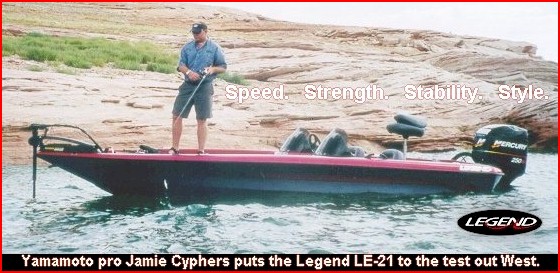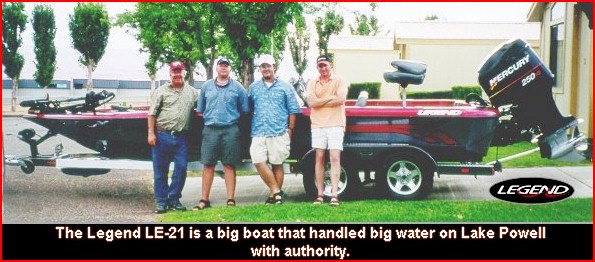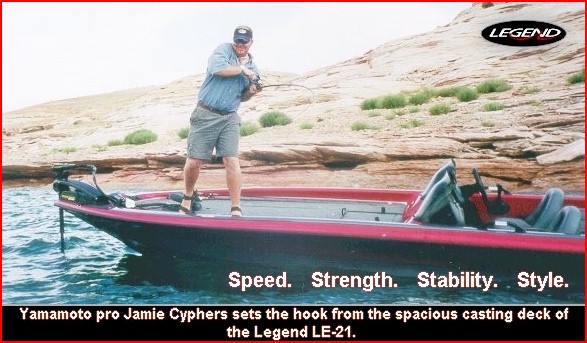|
A Legend Makes It Out West
June 28, 2004
 This weekend, I enjoyed the privilege to
help break in a brand new Legend boat that's making its way out
West. I'm glad to say we got some of the first fish smell into
its ample livewell. This weekend, I enjoyed the privilege to
help break in a brand new Legend boat that's making its way out
West. I'm glad to say we got some of the first fish smell into
its ample livewell.
Dean Smith, owner of Legend Boats and factory pro-staffer Andy
Scott stopped to visit on their excursion out west. They're
trekking a full circle from Legend Boats mountain home in
Mountain Home, Arkansas. They're making business stops to show
and tell about Legend Boats in Texas, Arizona, Utah, Nevada and
California. Then they're turning the boat back around to set sail
for Mountain Home.
New to the business, Legend Boats makes bass boats. Not bay
boats or walleye boats. Not saltwater flats boats. Neither
offshore nor inshore coastal boats. Not fish-n-skis or run-abouts.
Not duck boats, not skiffs, not pirogues. No aluminum hulls or
river-running jet-drives. Legend builds only fiberglass bass
boats.
"Always fear the man with one
gun" was some sort of line in a Western movie
maybe. I forget where I heard it, but the gunslinger who muttered
it meant that a white-hatted hero who has only one gun has
learned to use it exceedingly well.
Legend Boats has learned to build only bass boats exceedingly
well. They make three sizes, the LE-186 (18' 6"), the LE-195
(19' 5") and the LE-21 (20' 11"). Yamamoto pro Jamie
Cyphers, a veteran big water driver, put the LE-21 through the
paces on Lake Powell. Running thirty miles up lake and back,
handling wide open wind-swept basins, turning tightly at high
speed in three-foot wind-blown chop, necking through narrows
churning like a treacherous washing machine from non-stop
houseboat and tourist traffic jams, the ride was smooth and dry.
Navigating miles of torturous twisting, turning narrow canyons,
the responsiveness and driver's feeling of control never
faltered. The Legend LE-21 is a big bass boat that offers a
superior ride in big water.

Listening to owner Dean Smith speak about Legend Boat
features, they go well beyond what I've seen on most bass boats.
The LE-21 we ran had recessed cleats all around. Have you ever
draped a backlash over a cleat or gotten the net mesh snagged at
the worst moment? Not gonna happen on a Legend. Have you ever
been late getting back to a weigh-in because that last cast took
too long? That shouldn't happen either on a Legend since a
waterproof clock is built right into the bow instrument panel
right at your feet while you cast. Ever watch the runway lights
guide a plane safely into the airport at night? Your Legend
trailer has a string of guiding runway lights to let you recovery
your boat safely after dark. Fish getting stressed and losing
weight in the livewell? The Legend has red lights designed to
calm fish in the livewell. The Legend has red backlights on every
instrument and switch on the driver's console and side panels,
designed for protecting your eyesight when its most needed under
lowlight conditions. Every locker and hatch I opened had ample
illumination inside. Even back deck hatches had gas shock arm
levers to help hold them open hands-free. Now that I am thinking,
most storage lockers had padding inside, even under the lids.
Dean mentioned there's a lifetime warranty on the hull, transom,
and stringers plus unlimited horsepower to hang off the LE-21.
Hey, there's so much more you might want to know about Legend
Boats - speed, strength, stability and style - but Dean and Andy
didn't come over to give me a commercial and I'm not here to give
you one either. Fishing was the reason
for this visit and the reason for this article, so let's go. But
I will say, if a new bass boat is in your future, the Legend
should be on your short list for sure.

Crisscrossing Points and Bowls at
Daybreak
"We crisscrossed two tactics together for our first
pattern early in the day," says Bassdozer.
Most essential was to identify gamefish and baitfish in an
area. We motored around trying to find surface action signs. When
that failed, we motored around trying to find subsurface action
signs, which we did on the electronics. Then it became a
two-pronged early morning plan of attack, coursing through the
area with the trolling motor wide open:
 Points:
We'd coast down an irregular shoreline quickly, raking any points
we crossed over with deep-diving Norman DD14's for smallmouth. Points:
We'd coast down an irregular shoreline quickly, raking any points
we crossed over with deep-diving Norman DD14's for smallmouth.
- Bowls: As we trolled past
any indented bowls and washes in between points, we'd hurl heavy
Super Spooks way, way far back into any tumbleweeds for
largemouth. The Super Spook is a long distance champ. Not much
can outdistance a Spook. Using it saves time having to take the
boat in and out of the cuts and coves. We just traversed from
point to point, and if we could empty our spools back far enough
into the coves to get a Spook nearby tumbleweeds, it'd get
slapped by a largemouth.
In summer, it is important to work
the early morning pattern quickly and efficiently since it only
lasts the first two hours most days. It's usually the best bite
of the day by far, and you may as well put the boat back on the
trailer after that until evening.
Mid-Morning Dropshot
By mid-morning, it was turning into one of those tough summer
days. So the agenda turned to deepwater dropshot with 5-inch
wacky-rigged Senkos.
The bite was subtle - almost imperceptible but it was there. Every
fish I caught, I was never sure I had one until I set the hook on
a hunch. The fish wanted more MegaStrike than soft
plastic. The key to getting bit was smothering not only the soft
bait, but the line and Mojo dropshot sinker in MegaStrike gel. I
put eight or ten in the boat this way in two mid-morning hours.
The first hour, there was some hazy overcast so we laced our
lines with dark colors like 922 (black/red flash laminate). By
the second hour, the clouds burned off, we were fit to faint from
the sun and heat, and light colors like smoke w/purple and white
w/silver worked well.
Fishing with Legend factory pro staffer, Andy Scott, he hadn't
dropshot much back home in Arkansas. To Andy's credit, he gave
the new-fangled dropshot a chance, but after two fruitless hours,
wisely went to his Arkansas jigging stick and began picking up
bass on the jig just like back home. "The dropshot rig is often written and therefore
read about in recent years. Yet even out West where it first
appeared, most Western anglers I have met don't dropshot well,
often or at all," says Russ Bassdozer.

Bluffs After Noon
After sharing halves of a sandwich, some agua frķa fresca and
carrot sticks, we retired under the cool shade of deep main
channel bluffs. Andy had done well before lunch with a dark brown
skirted jig and orangey-pumpkin twin tail grub trailer. So I too
cinched on something similar - a brown and orange rubber flipping
jig with a burnt-orange Super Pork Senior.
"Fishing sheer bluffs over 400 feet deep was so unusual
to me, but we jigged smallmouth out of every nook and shady
cranny on some of those bluffs," says Legend factory pro,
Andy Scott of Mountain Home, Arkansas. "On lakes back home,
100 feet may be the maximum depth you might ever get down by the
dam. But fishing with Bassdozer, I think that old boy
considers 100 feet too shallow, let me tell you."

No Depth Required
You don't need anywhere near these depths for you to reproduce
what we did here on a hot summer day:
- Begin the early morning hours on irregular shallow shoreline
points and bowls with bait and cover.
- Move by mid-morning to deeper primary points ending off these
areas.
- By mid-day, move to steep main channel banks nearby.
Had we fished the rest of this summer day, we simply would
have reversed our moves back to the primary points by
mid-afternoon and back to the irregular shoreline points and
bowls with bait and cover by early evening. "It's a simple,
successful and reproducible script for a hot summer day,"
says Russ Bassdozer. You don't need anywhere near the depth of
Lake Powell to do it. Just customize
this script to the depth of your lake, whatever its depth may be,
and it will work for you some day this summer.
Visit Legend Boats website at www.legendmarine.com or ask to see Legend
Boats at your local boat dealer.
|
